Ethical, Legal, and Social Implications of IoT Data Marketing
VerifiedAdded on 2022/10/16
|6
|2354
|80
Report
AI Summary
This report delves into the ethical, legal, and social issues arising from the use of Internet of Things (IoT) data for marketing purposes. It explores the core components of IoT, including devices like thermostats and fitness trackers, and the potential for data collection to improve customer service through customized products. The report highlights the importance of trust in the IoT ecosystem, discussing the challenges of maintaining data privacy and balancing innovation with consumer protection. It examines the legal landscape, including regulations like the Australian Privacy Principles and the GDPR, and the implications of data breaches. The report emphasizes the importance of informed consent in data collection, the ethical considerations of using AI in IoT, and the need for robust privacy and security measures to protect consumer rights. It references academic and professional literature, including the ACS Code of Professional Conduct, to provide a comprehensive analysis of the ethical considerations surrounding the use of IoT data for marketing and offers insights into the responsible use of consumer data and the evolving landscape of data protection.
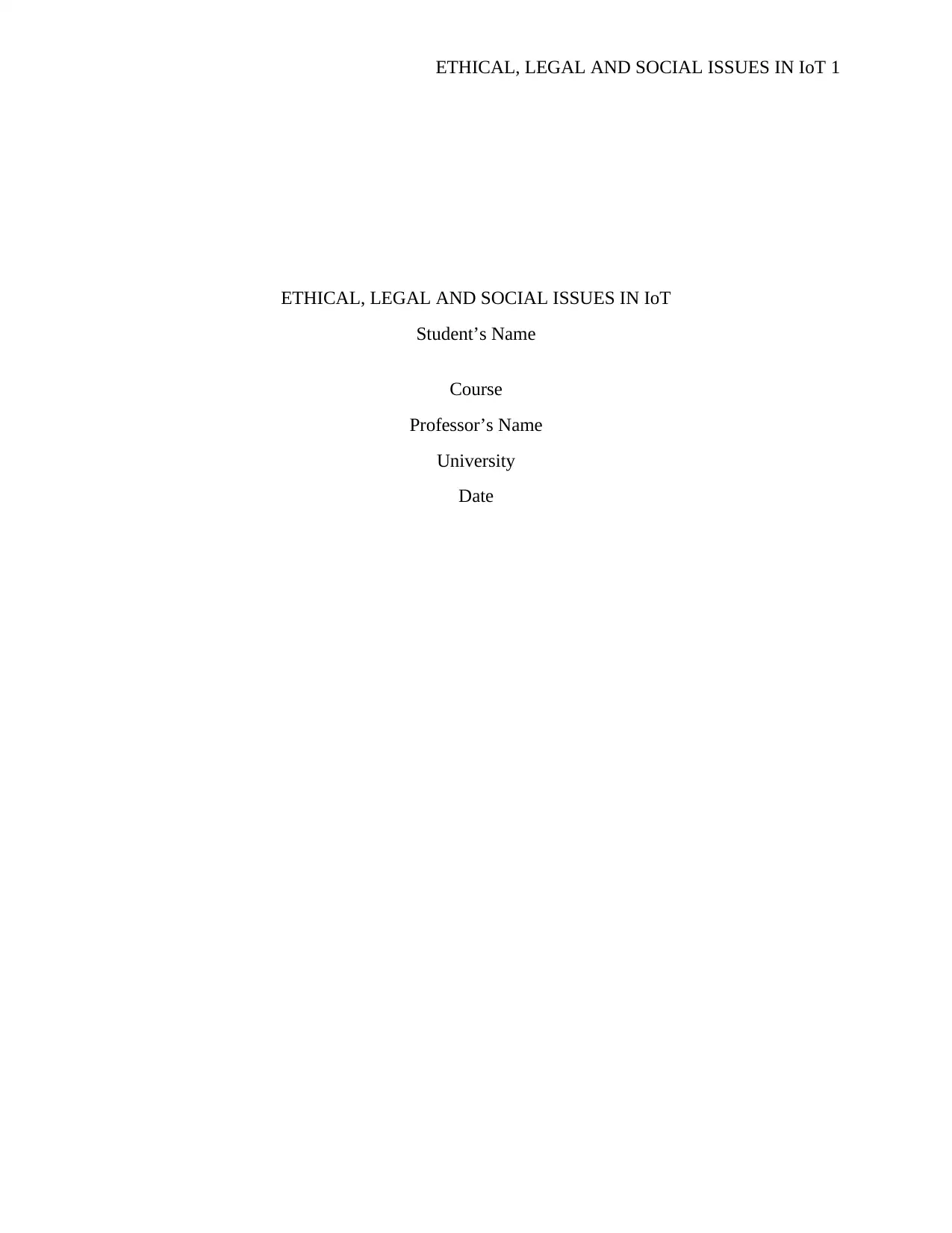
ETHICAL, LEGAL AND SOCIAL ISSUES IN IoT 1
ETHICAL, LEGAL AND SOCIAL ISSUES IN IoT
Student’s Name
Course
Professor’s Name
University
Date
ETHICAL, LEGAL AND SOCIAL ISSUES IN IoT
Student’s Name
Course
Professor’s Name
University
Date
Paraphrase This Document
Need a fresh take? Get an instant paraphrase of this document with our AI Paraphraser
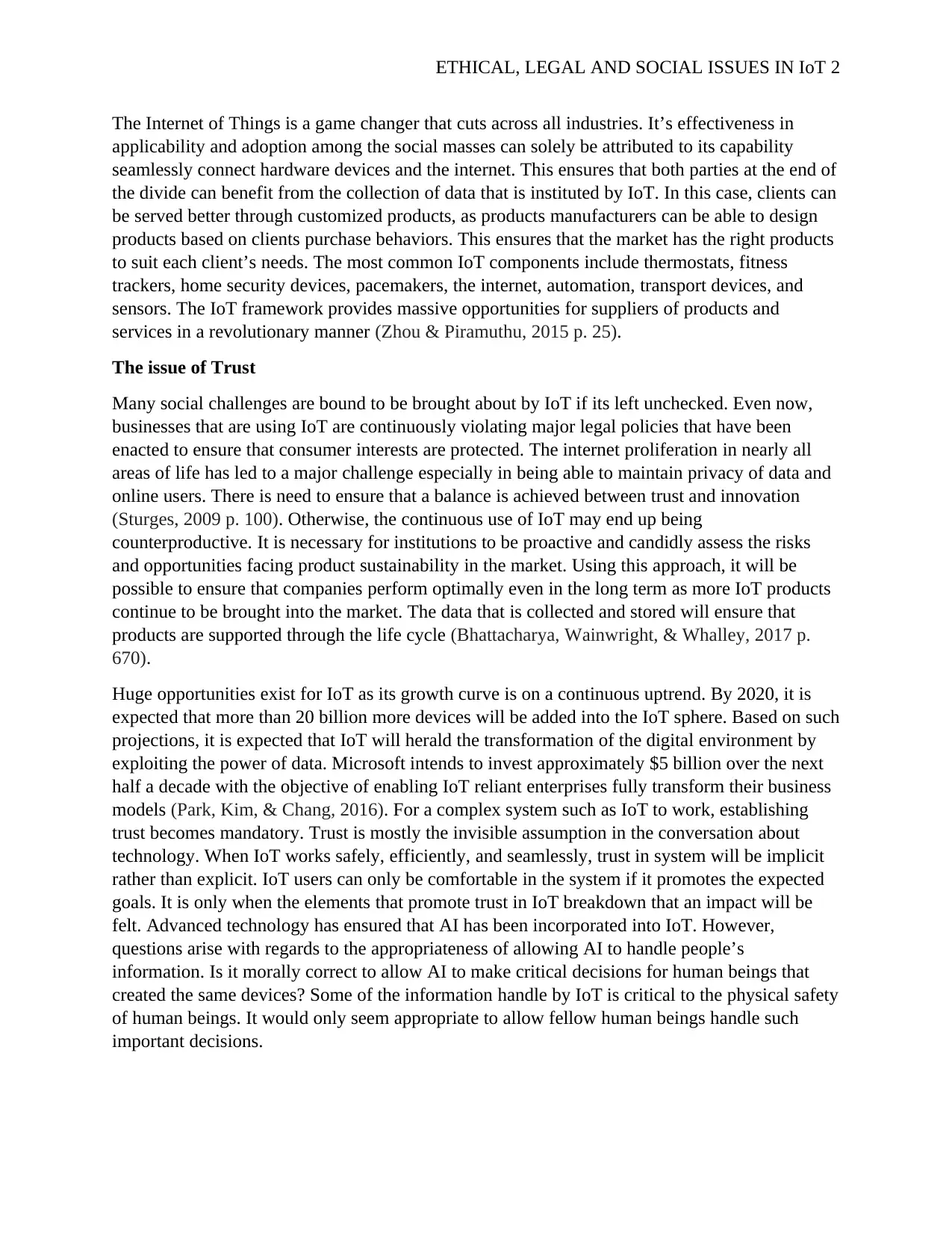
ETHICAL, LEGAL AND SOCIAL ISSUES IN IoT 2
The Internet of Things is a game changer that cuts across all industries. It’s effectiveness in
applicability and adoption among the social masses can solely be attributed to its capability
seamlessly connect hardware devices and the internet. This ensures that both parties at the end of
the divide can benefit from the collection of data that is instituted by IoT. In this case, clients can
be served better through customized products, as products manufacturers can be able to design
products based on clients purchase behaviors. This ensures that the market has the right products
to suit each client’s needs. The most common IoT components include thermostats, fitness
trackers, home security devices, pacemakers, the internet, automation, transport devices, and
sensors. The IoT framework provides massive opportunities for suppliers of products and
services in a revolutionary manner (Zhou & Piramuthu, 2015 p. 25).
The issue of Trust
Many social challenges are bound to be brought about by IoT if its left unchecked. Even now,
businesses that are using IoT are continuously violating major legal policies that have been
enacted to ensure that consumer interests are protected. The internet proliferation in nearly all
areas of life has led to a major challenge especially in being able to maintain privacy of data and
online users. There is need to ensure that a balance is achieved between trust and innovation
(Sturges, 2009 p. 100). Otherwise, the continuous use of IoT may end up being
counterproductive. It is necessary for institutions to be proactive and candidly assess the risks
and opportunities facing product sustainability in the market. Using this approach, it will be
possible to ensure that companies perform optimally even in the long term as more IoT products
continue to be brought into the market. The data that is collected and stored will ensure that
products are supported through the life cycle (Bhattacharya, Wainwright, & Whalley, 2017 p.
670).
Huge opportunities exist for IoT as its growth curve is on a continuous uptrend. By 2020, it is
expected that more than 20 billion more devices will be added into the IoT sphere. Based on such
projections, it is expected that IoT will herald the transformation of the digital environment by
exploiting the power of data. Microsoft intends to invest approximately $5 billion over the next
half a decade with the objective of enabling IoT reliant enterprises fully transform their business
models (Park, Kim, & Chang, 2016). For a complex system such as IoT to work, establishing
trust becomes mandatory. Trust is mostly the invisible assumption in the conversation about
technology. When IoT works safely, efficiently, and seamlessly, trust in system will be implicit
rather than explicit. IoT users can only be comfortable in the system if it promotes the expected
goals. It is only when the elements that promote trust in IoT breakdown that an impact will be
felt. Advanced technology has ensured that AI has been incorporated into IoT. However,
questions arise with regards to the appropriateness of allowing AI to handle people’s
information. Is it morally correct to allow AI to make critical decisions for human beings that
created the same devices? Some of the information handle by IoT is critical to the physical safety
of human beings. It would only seem appropriate to allow fellow human beings handle such
important decisions.
The Internet of Things is a game changer that cuts across all industries. It’s effectiveness in
applicability and adoption among the social masses can solely be attributed to its capability
seamlessly connect hardware devices and the internet. This ensures that both parties at the end of
the divide can benefit from the collection of data that is instituted by IoT. In this case, clients can
be served better through customized products, as products manufacturers can be able to design
products based on clients purchase behaviors. This ensures that the market has the right products
to suit each client’s needs. The most common IoT components include thermostats, fitness
trackers, home security devices, pacemakers, the internet, automation, transport devices, and
sensors. The IoT framework provides massive opportunities for suppliers of products and
services in a revolutionary manner (Zhou & Piramuthu, 2015 p. 25).
The issue of Trust
Many social challenges are bound to be brought about by IoT if its left unchecked. Even now,
businesses that are using IoT are continuously violating major legal policies that have been
enacted to ensure that consumer interests are protected. The internet proliferation in nearly all
areas of life has led to a major challenge especially in being able to maintain privacy of data and
online users. There is need to ensure that a balance is achieved between trust and innovation
(Sturges, 2009 p. 100). Otherwise, the continuous use of IoT may end up being
counterproductive. It is necessary for institutions to be proactive and candidly assess the risks
and opportunities facing product sustainability in the market. Using this approach, it will be
possible to ensure that companies perform optimally even in the long term as more IoT products
continue to be brought into the market. The data that is collected and stored will ensure that
products are supported through the life cycle (Bhattacharya, Wainwright, & Whalley, 2017 p.
670).
Huge opportunities exist for IoT as its growth curve is on a continuous uptrend. By 2020, it is
expected that more than 20 billion more devices will be added into the IoT sphere. Based on such
projections, it is expected that IoT will herald the transformation of the digital environment by
exploiting the power of data. Microsoft intends to invest approximately $5 billion over the next
half a decade with the objective of enabling IoT reliant enterprises fully transform their business
models (Park, Kim, & Chang, 2016). For a complex system such as IoT to work, establishing
trust becomes mandatory. Trust is mostly the invisible assumption in the conversation about
technology. When IoT works safely, efficiently, and seamlessly, trust in system will be implicit
rather than explicit. IoT users can only be comfortable in the system if it promotes the expected
goals. It is only when the elements that promote trust in IoT breakdown that an impact will be
felt. Advanced technology has ensured that AI has been incorporated into IoT. However,
questions arise with regards to the appropriateness of allowing AI to handle people’s
information. Is it morally correct to allow AI to make critical decisions for human beings that
created the same devices? Some of the information handle by IoT is critical to the physical safety
of human beings. It would only seem appropriate to allow fellow human beings handle such
important decisions.
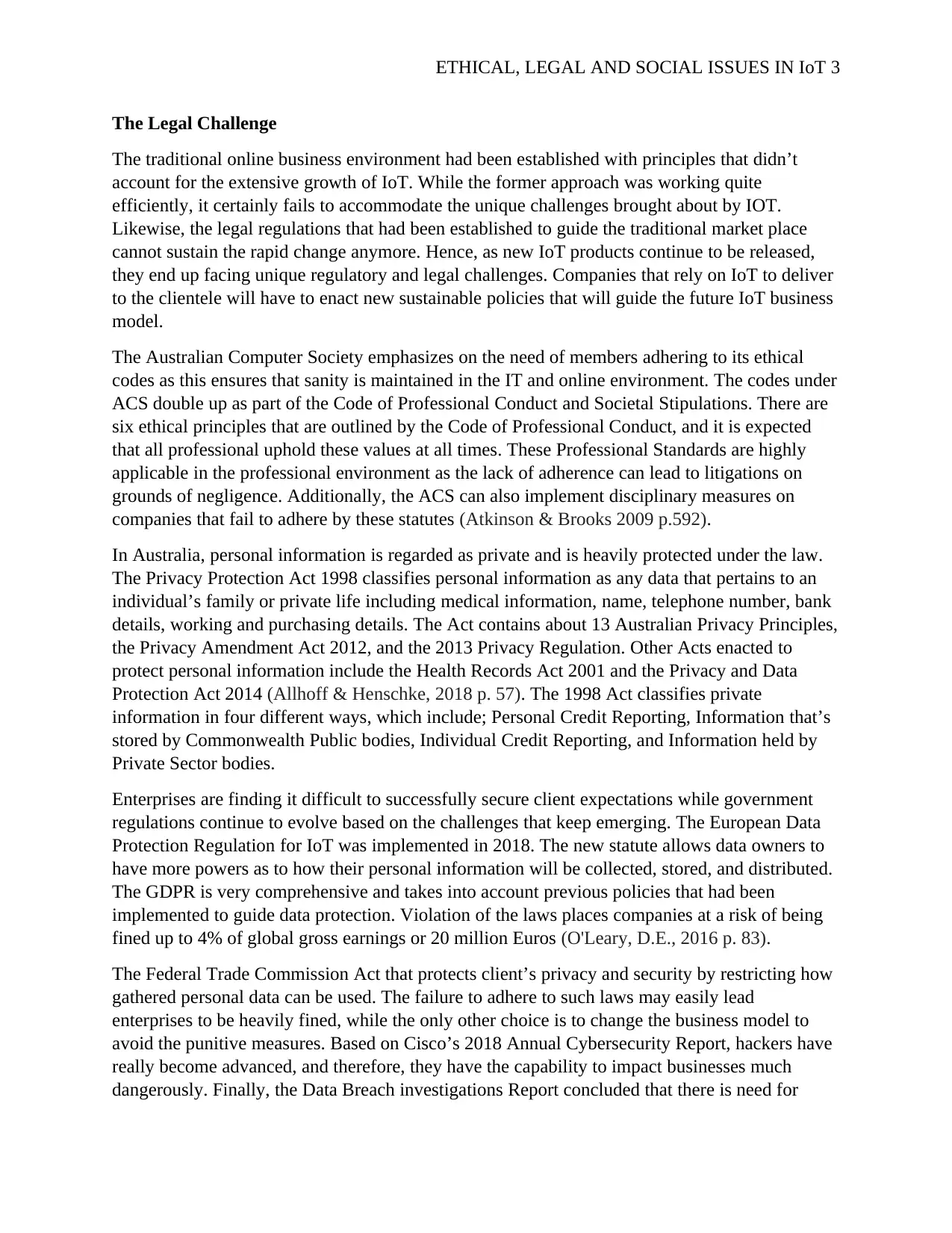
ETHICAL, LEGAL AND SOCIAL ISSUES IN IoT 3
The Legal Challenge
The traditional online business environment had been established with principles that didn’t
account for the extensive growth of IoT. While the former approach was working quite
efficiently, it certainly fails to accommodate the unique challenges brought about by IOT.
Likewise, the legal regulations that had been established to guide the traditional market place
cannot sustain the rapid change anymore. Hence, as new IoT products continue to be released,
they end up facing unique regulatory and legal challenges. Companies that rely on IoT to deliver
to the clientele will have to enact new sustainable policies that will guide the future IoT business
model.
The Australian Computer Society emphasizes on the need of members adhering to its ethical
codes as this ensures that sanity is maintained in the IT and online environment. The codes under
ACS double up as part of the Code of Professional Conduct and Societal Stipulations. There are
six ethical principles that are outlined by the Code of Professional Conduct, and it is expected
that all professional uphold these values at all times. These Professional Standards are highly
applicable in the professional environment as the lack of adherence can lead to litigations on
grounds of negligence. Additionally, the ACS can also implement disciplinary measures on
companies that fail to adhere by these statutes (Atkinson & Brooks 2009 p.592).
In Australia, personal information is regarded as private and is heavily protected under the law.
The Privacy Protection Act 1998 classifies personal information as any data that pertains to an
individual’s family or private life including medical information, name, telephone number, bank
details, working and purchasing details. The Act contains about 13 Australian Privacy Principles,
the Privacy Amendment Act 2012, and the 2013 Privacy Regulation. Other Acts enacted to
protect personal information include the Health Records Act 2001 and the Privacy and Data
Protection Act 2014 (Allhoff & Henschke, 2018 p. 57). The 1998 Act classifies private
information in four different ways, which include; Personal Credit Reporting, Information that’s
stored by Commonwealth Public bodies, Individual Credit Reporting, and Information held by
Private Sector bodies.
Enterprises are finding it difficult to successfully secure client expectations while government
regulations continue to evolve based on the challenges that keep emerging. The European Data
Protection Regulation for IoT was implemented in 2018. The new statute allows data owners to
have more powers as to how their personal information will be collected, stored, and distributed.
The GDPR is very comprehensive and takes into account previous policies that had been
implemented to guide data protection. Violation of the laws places companies at a risk of being
fined up to 4% of global gross earnings or 20 million Euros (O'Leary, D.E., 2016 p. 83).
The Federal Trade Commission Act that protects client’s privacy and security by restricting how
gathered personal data can be used. The failure to adhere to such laws may easily lead
enterprises to be heavily fined, while the only other choice is to change the business model to
avoid the punitive measures. Based on Cisco’s 2018 Annual Cybersecurity Report, hackers have
really become advanced, and therefore, they have the capability to impact businesses much
dangerously. Finally, the Data Breach investigations Report concluded that there is need for
The Legal Challenge
The traditional online business environment had been established with principles that didn’t
account for the extensive growth of IoT. While the former approach was working quite
efficiently, it certainly fails to accommodate the unique challenges brought about by IOT.
Likewise, the legal regulations that had been established to guide the traditional market place
cannot sustain the rapid change anymore. Hence, as new IoT products continue to be released,
they end up facing unique regulatory and legal challenges. Companies that rely on IoT to deliver
to the clientele will have to enact new sustainable policies that will guide the future IoT business
model.
The Australian Computer Society emphasizes on the need of members adhering to its ethical
codes as this ensures that sanity is maintained in the IT and online environment. The codes under
ACS double up as part of the Code of Professional Conduct and Societal Stipulations. There are
six ethical principles that are outlined by the Code of Professional Conduct, and it is expected
that all professional uphold these values at all times. These Professional Standards are highly
applicable in the professional environment as the lack of adherence can lead to litigations on
grounds of negligence. Additionally, the ACS can also implement disciplinary measures on
companies that fail to adhere by these statutes (Atkinson & Brooks 2009 p.592).
In Australia, personal information is regarded as private and is heavily protected under the law.
The Privacy Protection Act 1998 classifies personal information as any data that pertains to an
individual’s family or private life including medical information, name, telephone number, bank
details, working and purchasing details. The Act contains about 13 Australian Privacy Principles,
the Privacy Amendment Act 2012, and the 2013 Privacy Regulation. Other Acts enacted to
protect personal information include the Health Records Act 2001 and the Privacy and Data
Protection Act 2014 (Allhoff & Henschke, 2018 p. 57). The 1998 Act classifies private
information in four different ways, which include; Personal Credit Reporting, Information that’s
stored by Commonwealth Public bodies, Individual Credit Reporting, and Information held by
Private Sector bodies.
Enterprises are finding it difficult to successfully secure client expectations while government
regulations continue to evolve based on the challenges that keep emerging. The European Data
Protection Regulation for IoT was implemented in 2018. The new statute allows data owners to
have more powers as to how their personal information will be collected, stored, and distributed.
The GDPR is very comprehensive and takes into account previous policies that had been
implemented to guide data protection. Violation of the laws places companies at a risk of being
fined up to 4% of global gross earnings or 20 million Euros (O'Leary, D.E., 2016 p. 83).
The Federal Trade Commission Act that protects client’s privacy and security by restricting how
gathered personal data can be used. The failure to adhere to such laws may easily lead
enterprises to be heavily fined, while the only other choice is to change the business model to
avoid the punitive measures. Based on Cisco’s 2018 Annual Cybersecurity Report, hackers have
really become advanced, and therefore, they have the capability to impact businesses much
dangerously. Finally, the Data Breach investigations Report concluded that there is need for
⊘ This is a preview!⊘
Do you want full access?
Subscribe today to unlock all pages.

Trusted by 1+ million students worldwide
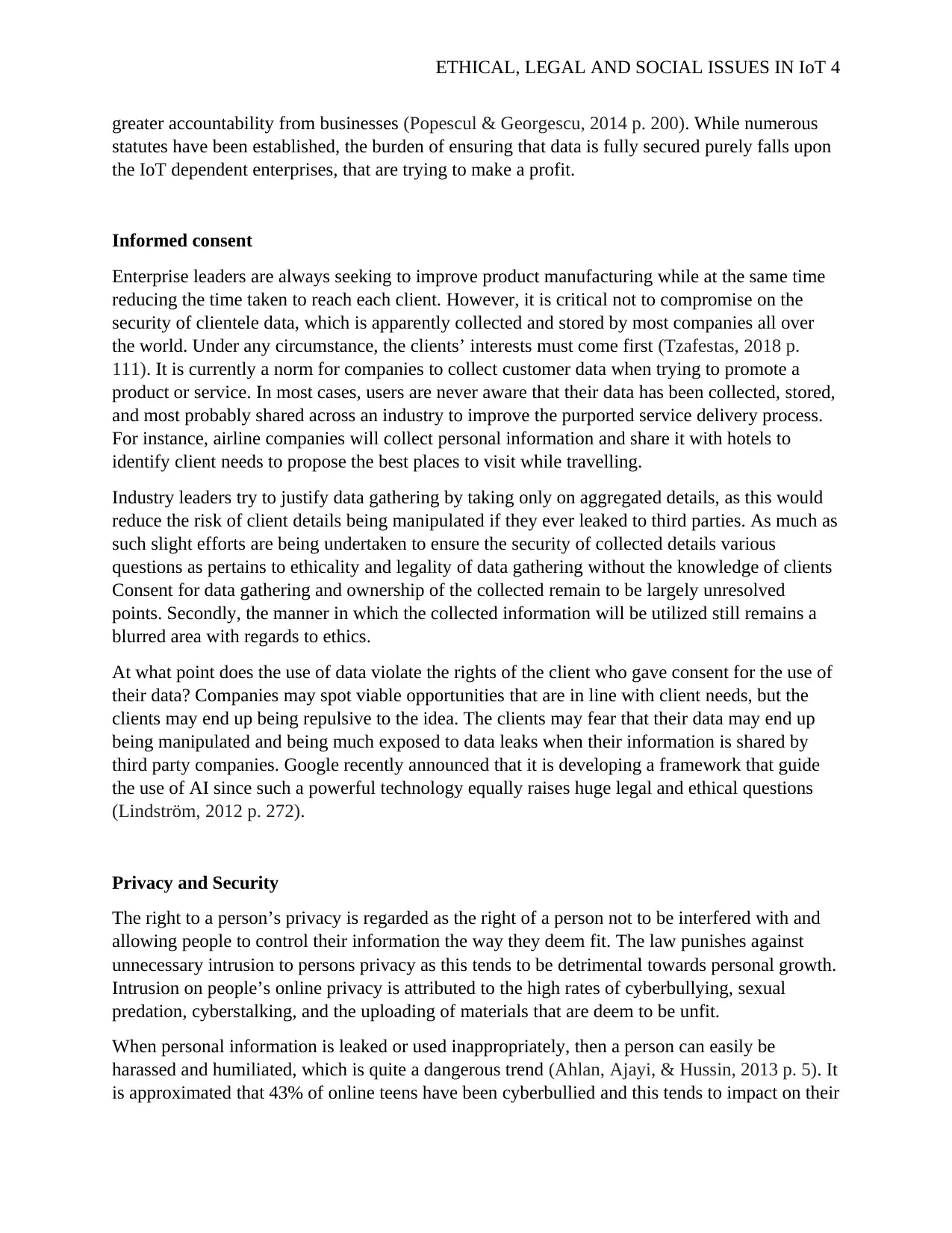
ETHICAL, LEGAL AND SOCIAL ISSUES IN IoT 4
greater accountability from businesses (Popescul & Georgescu, 2014 p. 200). While numerous
statutes have been established, the burden of ensuring that data is fully secured purely falls upon
the IoT dependent enterprises, that are trying to make a profit.
Informed consent
Enterprise leaders are always seeking to improve product manufacturing while at the same time
reducing the time taken to reach each client. However, it is critical not to compromise on the
security of clientele data, which is apparently collected and stored by most companies all over
the world. Under any circumstance, the clients’ interests must come first (Tzafestas, 2018 p.
111). It is currently a norm for companies to collect customer data when trying to promote a
product or service. In most cases, users are never aware that their data has been collected, stored,
and most probably shared across an industry to improve the purported service delivery process.
For instance, airline companies will collect personal information and share it with hotels to
identify client needs to propose the best places to visit while travelling.
Industry leaders try to justify data gathering by taking only on aggregated details, as this would
reduce the risk of client details being manipulated if they ever leaked to third parties. As much as
such slight efforts are being undertaken to ensure the security of collected details various
questions as pertains to ethicality and legality of data gathering without the knowledge of clients
Consent for data gathering and ownership of the collected remain to be largely unresolved
points. Secondly, the manner in which the collected information will be utilized still remains a
blurred area with regards to ethics.
At what point does the use of data violate the rights of the client who gave consent for the use of
their data? Companies may spot viable opportunities that are in line with client needs, but the
clients may end up being repulsive to the idea. The clients may fear that their data may end up
being manipulated and being much exposed to data leaks when their information is shared by
third party companies. Google recently announced that it is developing a framework that guide
the use of AI since such a powerful technology equally raises huge legal and ethical questions
(Lindström, 2012 p. 272).
Privacy and Security
The right to a person’s privacy is regarded as the right of a person not to be interfered with and
allowing people to control their information the way they deem fit. The law punishes against
unnecessary intrusion to persons privacy as this tends to be detrimental towards personal growth.
Intrusion on people’s online privacy is attributed to the high rates of cyberbullying, sexual
predation, cyberstalking, and the uploading of materials that are deem to be unfit.
When personal information is leaked or used inappropriately, then a person can easily be
harassed and humiliated, which is quite a dangerous trend (Ahlan, Ajayi, & Hussin, 2013 p. 5). It
is approximated that 43% of online teens have been cyberbullied and this tends to impact on their
greater accountability from businesses (Popescul & Georgescu, 2014 p. 200). While numerous
statutes have been established, the burden of ensuring that data is fully secured purely falls upon
the IoT dependent enterprises, that are trying to make a profit.
Informed consent
Enterprise leaders are always seeking to improve product manufacturing while at the same time
reducing the time taken to reach each client. However, it is critical not to compromise on the
security of clientele data, which is apparently collected and stored by most companies all over
the world. Under any circumstance, the clients’ interests must come first (Tzafestas, 2018 p.
111). It is currently a norm for companies to collect customer data when trying to promote a
product or service. In most cases, users are never aware that their data has been collected, stored,
and most probably shared across an industry to improve the purported service delivery process.
For instance, airline companies will collect personal information and share it with hotels to
identify client needs to propose the best places to visit while travelling.
Industry leaders try to justify data gathering by taking only on aggregated details, as this would
reduce the risk of client details being manipulated if they ever leaked to third parties. As much as
such slight efforts are being undertaken to ensure the security of collected details various
questions as pertains to ethicality and legality of data gathering without the knowledge of clients
Consent for data gathering and ownership of the collected remain to be largely unresolved
points. Secondly, the manner in which the collected information will be utilized still remains a
blurred area with regards to ethics.
At what point does the use of data violate the rights of the client who gave consent for the use of
their data? Companies may spot viable opportunities that are in line with client needs, but the
clients may end up being repulsive to the idea. The clients may fear that their data may end up
being manipulated and being much exposed to data leaks when their information is shared by
third party companies. Google recently announced that it is developing a framework that guide
the use of AI since such a powerful technology equally raises huge legal and ethical questions
(Lindström, 2012 p. 272).
Privacy and Security
The right to a person’s privacy is regarded as the right of a person not to be interfered with and
allowing people to control their information the way they deem fit. The law punishes against
unnecessary intrusion to persons privacy as this tends to be detrimental towards personal growth.
Intrusion on people’s online privacy is attributed to the high rates of cyberbullying, sexual
predation, cyberstalking, and the uploading of materials that are deem to be unfit.
When personal information is leaked or used inappropriately, then a person can easily be
harassed and humiliated, which is quite a dangerous trend (Ahlan, Ajayi, & Hussin, 2013 p. 5). It
is approximated that 43% of online teens have been cyberbullied and this tends to impact on their
Paraphrase This Document
Need a fresh take? Get an instant paraphrase of this document with our AI Paraphraser
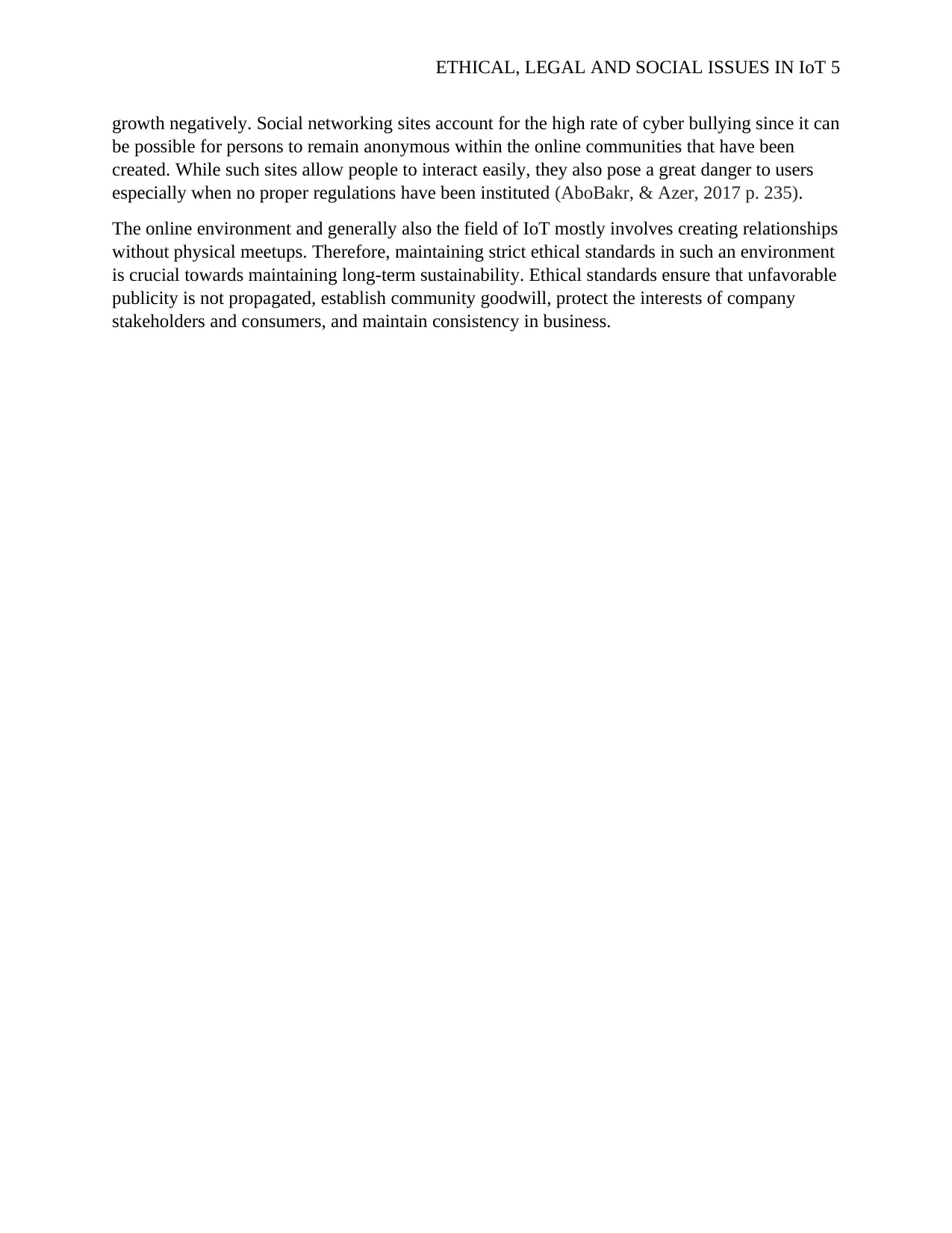
ETHICAL, LEGAL AND SOCIAL ISSUES IN IoT 5
growth negatively. Social networking sites account for the high rate of cyber bullying since it can
be possible for persons to remain anonymous within the online communities that have been
created. While such sites allow people to interact easily, they also pose a great danger to users
especially when no proper regulations have been instituted (AboBakr, & Azer, 2017 p. 235).
The online environment and generally also the field of IoT mostly involves creating relationships
without physical meetups. Therefore, maintaining strict ethical standards in such an environment
is crucial towards maintaining long-term sustainability. Ethical standards ensure that unfavorable
publicity is not propagated, establish community goodwill, protect the interests of company
stakeholders and consumers, and maintain consistency in business.
growth negatively. Social networking sites account for the high rate of cyber bullying since it can
be possible for persons to remain anonymous within the online communities that have been
created. While such sites allow people to interact easily, they also pose a great danger to users
especially when no proper regulations have been instituted (AboBakr, & Azer, 2017 p. 235).
The online environment and generally also the field of IoT mostly involves creating relationships
without physical meetups. Therefore, maintaining strict ethical standards in such an environment
is crucial towards maintaining long-term sustainability. Ethical standards ensure that unfavorable
publicity is not propagated, establish community goodwill, protect the interests of company
stakeholders and consumers, and maintain consistency in business.
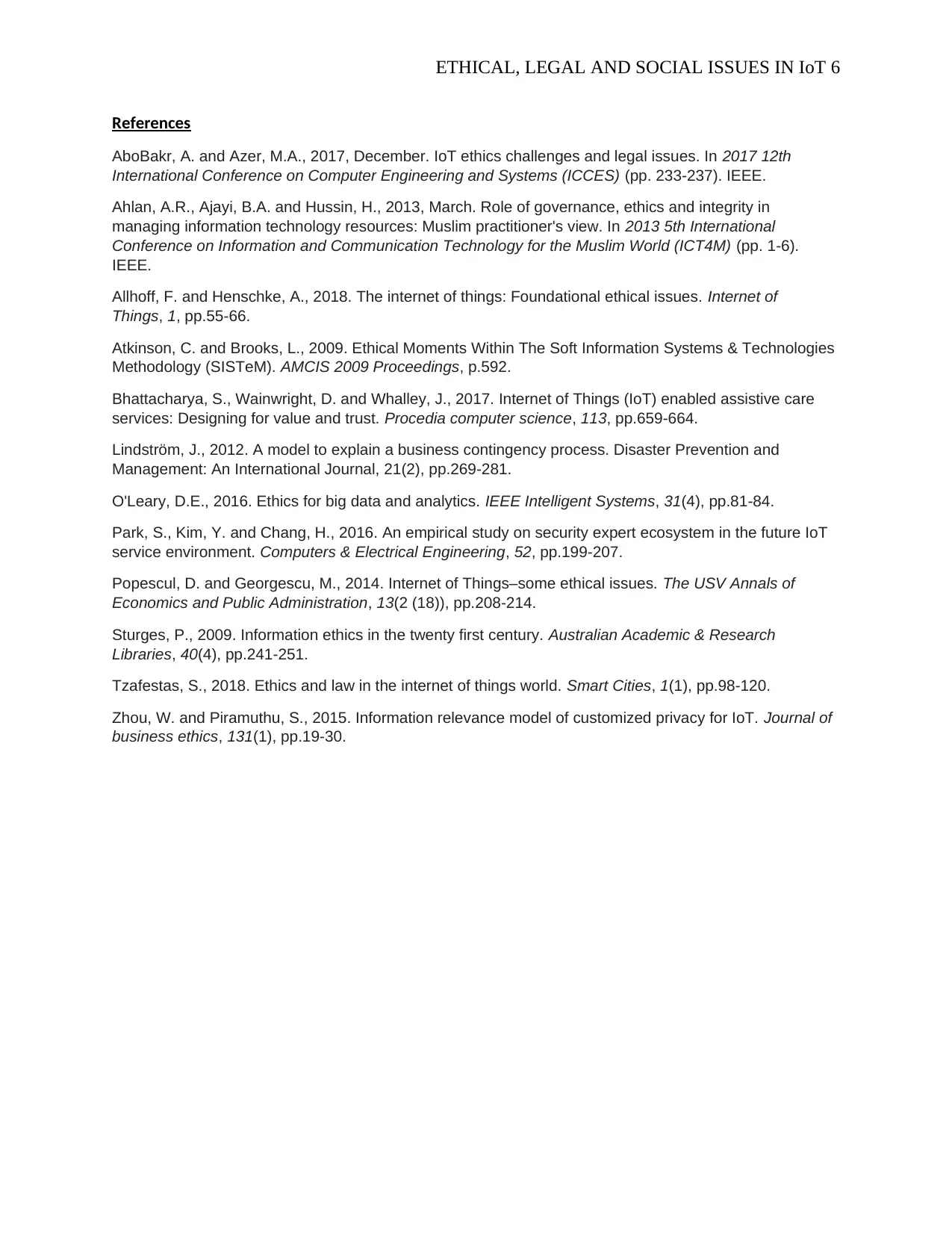
ETHICAL, LEGAL AND SOCIAL ISSUES IN IoT 6
References
AboBakr, A. and Azer, M.A., 2017, December. IoT ethics challenges and legal issues. In 2017 12th
International Conference on Computer Engineering and Systems (ICCES) (pp. 233-237). IEEE.
Ahlan, A.R., Ajayi, B.A. and Hussin, H., 2013, March. Role of governance, ethics and integrity in
managing information technology resources: Muslim practitioner's view. In 2013 5th International
Conference on Information and Communication Technology for the Muslim World (ICT4M) (pp. 1-6).
IEEE.
Allhoff, F. and Henschke, A., 2018. The internet of things: Foundational ethical issues. Internet of
Things, 1, pp.55-66.
Atkinson, C. and Brooks, L., 2009. Ethical Moments Within The Soft Information Systems & Technologies
Methodology (SISTeM). AMCIS 2009 Proceedings, p.592.
Bhattacharya, S., Wainwright, D. and Whalley, J., 2017. Internet of Things (IoT) enabled assistive care
services: Designing for value and trust. Procedia computer science, 113, pp.659-664.
Lindström, J., 2012. A model to explain a business contingency process. Disaster Prevention and
Management: An International Journal, 21(2), pp.269-281.
O'Leary, D.E., 2016. Ethics for big data and analytics. IEEE Intelligent Systems, 31(4), pp.81-84.
Park, S., Kim, Y. and Chang, H., 2016. An empirical study on security expert ecosystem in the future IoT
service environment. Computers & Electrical Engineering, 52, pp.199-207.
Popescul, D. and Georgescu, M., 2014. Internet of Things–some ethical issues. The USV Annals of
Economics and Public Administration, 13(2 (18)), pp.208-214.
Sturges, P., 2009. Information ethics in the twenty first century. Australian Academic & Research
Libraries, 40(4), pp.241-251.
Tzafestas, S., 2018. Ethics and law in the internet of things world. Smart Cities, 1(1), pp.98-120.
Zhou, W. and Piramuthu, S., 2015. Information relevance model of customized privacy for IoT. Journal of
business ethics, 131(1), pp.19-30.
References
AboBakr, A. and Azer, M.A., 2017, December. IoT ethics challenges and legal issues. In 2017 12th
International Conference on Computer Engineering and Systems (ICCES) (pp. 233-237). IEEE.
Ahlan, A.R., Ajayi, B.A. and Hussin, H., 2013, March. Role of governance, ethics and integrity in
managing information technology resources: Muslim practitioner's view. In 2013 5th International
Conference on Information and Communication Technology for the Muslim World (ICT4M) (pp. 1-6).
IEEE.
Allhoff, F. and Henschke, A., 2018. The internet of things: Foundational ethical issues. Internet of
Things, 1, pp.55-66.
Atkinson, C. and Brooks, L., 2009. Ethical Moments Within The Soft Information Systems & Technologies
Methodology (SISTeM). AMCIS 2009 Proceedings, p.592.
Bhattacharya, S., Wainwright, D. and Whalley, J., 2017. Internet of Things (IoT) enabled assistive care
services: Designing for value and trust. Procedia computer science, 113, pp.659-664.
Lindström, J., 2012. A model to explain a business contingency process. Disaster Prevention and
Management: An International Journal, 21(2), pp.269-281.
O'Leary, D.E., 2016. Ethics for big data and analytics. IEEE Intelligent Systems, 31(4), pp.81-84.
Park, S., Kim, Y. and Chang, H., 2016. An empirical study on security expert ecosystem in the future IoT
service environment. Computers & Electrical Engineering, 52, pp.199-207.
Popescul, D. and Georgescu, M., 2014. Internet of Things–some ethical issues. The USV Annals of
Economics and Public Administration, 13(2 (18)), pp.208-214.
Sturges, P., 2009. Information ethics in the twenty first century. Australian Academic & Research
Libraries, 40(4), pp.241-251.
Tzafestas, S., 2018. Ethics and law in the internet of things world. Smart Cities, 1(1), pp.98-120.
Zhou, W. and Piramuthu, S., 2015. Information relevance model of customized privacy for IoT. Journal of
business ethics, 131(1), pp.19-30.
⊘ This is a preview!⊘
Do you want full access?
Subscribe today to unlock all pages.

Trusted by 1+ million students worldwide
1 out of 6
Related Documents
Your All-in-One AI-Powered Toolkit for Academic Success.
+13062052269
info@desklib.com
Available 24*7 on WhatsApp / Email
![[object Object]](/_next/static/media/star-bottom.7253800d.svg)
Unlock your academic potential
Copyright © 2020–2025 A2Z Services. All Rights Reserved. Developed and managed by ZUCOL.




